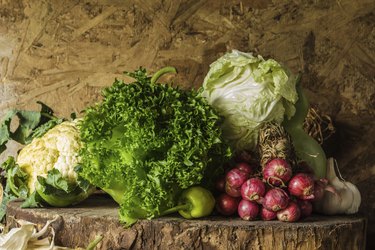
The last green tomatoes blush on the vine and squash leaves curl yellow at the edges, but there's no need for garden nostalgia. It's time to grab that spade and head back out to start your fall veggies. The garden you plant as summer melts into autumn provides varied, nutrition-packed eating through the beginning of winter. Think leafy like lettuce, cruciferous like broccoli, but that's just the beginning of the "cool weather crops."
Garden people divide vegetables into two categories, warm season crops that need hot sun to mature, and cool season veggies that prefer brisker weather. These cool-weather tough guys tolerate light frost and some even shake off temperature drops to 20 degrees Fahrenheit. Just remember to offer fall garden plants a sunny location, soil with ample organic content and regular irrigation and you'll be eating home-grown through the holidays and beyond.
Video of the Day
Video of the Day
8. Let Us Grow Lettuce
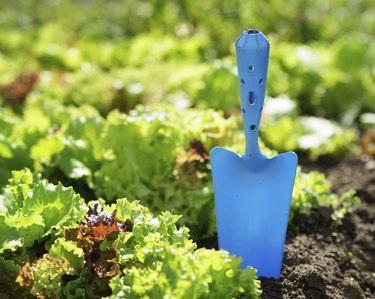
To a gardener's eye, nothing is more beautiful than the bright, crisp leaves of garden lettuce (Lactuca sativa), from relaxed, loose-leaf varieties to stiff, stand-up Romaine. Lettuce won't grow sweet and tender in the scorching summer sun, so put those seeds or seedlings in the ground about the time the kids go back to school. This is an easy-sneezy fall crop; you basically plant it, water it to keep the soil constantly moist to 6 inches, and harvest a few months later. Plant seeds two-week intervals to keep the lettuce coming.
7. Super-Veggie Broccoli
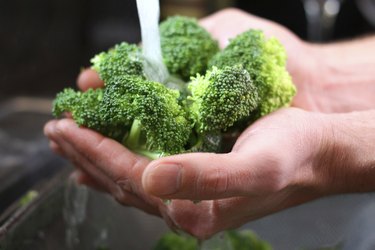
Former President Bush famously dissed broccoli (Brassica oleracea italica) by saying he'd hated it all his life, but this super-veggie may have the larger fan club. A great source of vitamins C and D as well as nutrients that fight inflammation and cancer, broccoli is also just plain yummy if it isn't cooked into mush. Broccoli must come to harvest in temperatures below 75 degrees Fahrenheit, so post-summer planting is ideal. Count at least 70 days from seed to harvest, or cut that time by using transplants. Broccoli's a survivor so don't fret over a little frost.
6. Can't Fail Kale
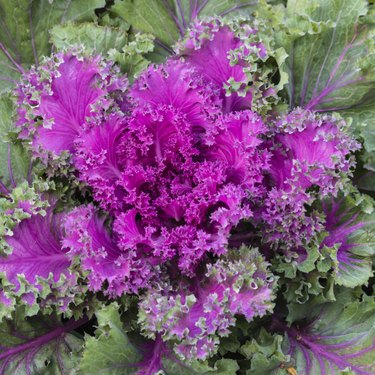
If frost comes early where you live, think kale (Brassica oleracea var. acephal) for fall planting since you can harvest this fast-growing vegetable a mere 30 days after planting. Mature kale looks like cabbage that had a few drinks, with relaxed, loose leaves perfect for raw salads or steaming. In many zones, kale is a cash-cow crop since you can harvest outer leaves all winter long. These antioxidant-rich vegetables keep their cool down to 20 degrees. The health benefits of kale would fill a book, but the ornamental varieties also provide eye candy with their gorgeous magenta leaves.
5. Luscious Leeks
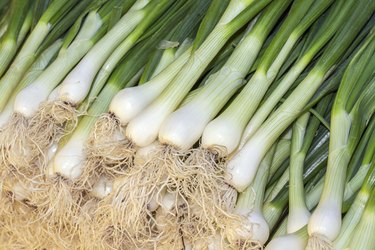
Americans call leeks elegant onions, while the French label their beloved "poirots" poor man's asparagus. Vegetable hierarchy aside, luscious leeks (Allium porrum) belong to the onion family and are cold-hardy crops just made for fall planting. To increase the sweet, white section of the stem, hill soil around the stalks as they develop. The veggies will be ready for that soupe--de poireaux recipe (or just plain steaming) in about 80 to 100 days. It's no problem if your leek-bin runneth over; you can store them in a cool, moist location for two or three months.
4. Sweet Fall Cabbage

"Having a good wife and rich cabbage soup, seek not other things," advises a Russian proverb; you can get a head start on this simple bliss by including cabbage in your fall garden. Cabbage (Brassica oleracea) is sweetest if it matures in cool weather, and early fall planting yields a harvest two to six months later, depending on cultivar, climate and whether you use transplants or seeds. Just because the cabbages at your grocery store are uniformly round and green doesn't mean that's your only choice: cultivars also offer flat, or pointed heads and crinkled leaves in hues of red and purple.
3. Double-Duty Beets
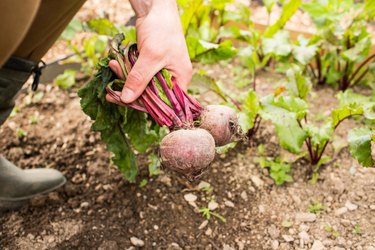
Home-grown beets (Beta vulgaris) offer double happiness. The rich, rounded root can fly solo or liven up a salad, and the vitamin-packed greens are delicious steamed or roasted. Don't feel stuck with the deep-purple varieties; you'll find cultivars with pink, red, yellow, orange and even cany-striped beetroots. Fall is an optimal time for planting beets, since they need temperatures below 65 degrees Fahrenheit to mature. Harvest time is flexible; the greens are most tender about 6 inches tall, and the beetroots sweetest when 2 inches in diameter.
2. Garlands of Garlic
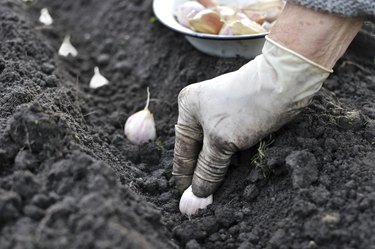
Be warned: once you taste the deep, subtle flavors of garden garlic, you won't tolerate generic bulbs from the grocery store. Planting your own garlic (Allium sativum var. sativum and ophiosco) requires only garlic cloves, and one pound of cloves yields some 10 pounds of crop. Don't use bland commercial garlic as planting stock; instead select great garden garlic from your local suppliers and get those cloves in the soil (pointed end up!) and establishing roots before winter arrives. They'll be ready for harvest the following summer.
1. Crunchy Red Radishes
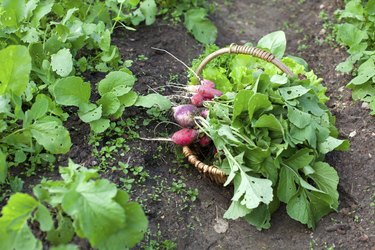
A radish may be the smallest crucifer vegetable, but it makes each bite count, a little spicy kick with a great crunch. Salad radishes (Raphanus sativus), the small red-skinned kind that are eaten raw, belong in the fall garden in mild climates where they ripen in less than two months. For cooler regions, look to winter radishes (Raphanus sativus longipinnatus); their roots are longer and oblong and need a little more time in the ground.
- Sloat Gardens: Fall
- P. Pallen Smith: What to Plant in Your Fall Vegetable Garden
- Clemson Cooperative University: Lettuce
- World's Healthiest Foods: Broccoli
- Harvest to Table: How to Brow Broccoli
- Floridata: Brassica Oleracea Var. Acephala
- Harvest to Table: How to Grow Leeks
- Harvest to Table: How to Grow Cabbage
- Bonnie Plants: Growing Cabbage
- Harvest to Table: How to Grow Beets
- Ohio State University Extension: Growing Beets in the Home Garden
- Fine Gardening: Grow Your Own Garlic
- Cornell University: Garlic
- Harvest to Table: How to Grow Radish
- Floridata: Raphanus Sativus
- Bonnie Plants: Harvest Guide for Cool Weather Vegetables
- Mother Earth News: All About Growing Lettuce